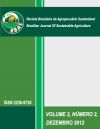AGROFORESTS AND ENVIRONMENTAL SERVICES: SPECIES FOR SUCCESIONAL TURNOVER AND GENE FLOW FACILITATION
DOI:
https://doi.org/10.21206/rbas.v2i2.180Abstract
Gene flow facilitation is an Agroforest potential environment service. Agroforest also needs economic alternatives in the long run. The aim of this research was to study Cooperafloresta Agroforest's landscape domestication and environmental service, and to select tree species that have economic potential and are adequate for bioindication and that also have potential to facilitate gene flow. There are two landscape domestication methods: Agroforest plots and Capoeira (regeneration) plots. Capoeira plots are the actual landscape matrix in these properties. In Agroforests it was identified 222 plant especies. Carbon biomass varied from 39.56 to 129.06 Mg C ha-1 and the annual carbon increment rate from 6.59 to 21.51 Mg C ha-1. Agroforests promote tropical forest restoration and higher carbon fixation rates. The species Zanthoxylum rhoifolium, Campomanesia xanthocarpa, Prunus sellowi, Centrolobium spp and Citharexylum myrianthum are the ones indicated.Downloads
Download data is not yet available.
Downloads
Published
2012-12-01
How to Cite
Carlos Eduardo Sícoli Seoane, Rodrigo Ozelame Silva, Walter Steenbock, Wilnatã Maschio, Isaque Leal Pinkuss, Luiz Paulo Gnatta Salmon, Raphael Snak Serafim da Luz, & Luís Cláudio Maranhão Froufe. (2012). AGROFORESTS AND ENVIRONMENTAL SERVICES: SPECIES FOR SUCCESIONAL TURNOVER AND GENE FLOW FACILITATION. Brazilian Journal of Sustainable Agriculture, 2(2). https://doi.org/10.21206/rbas.v2i2.180
Issue
Section
Artigos
License
1. Proposta de Política para Periódicos de Acesso Livre
Autores que publicam nesta revista concordam com os seguintes termos:
Autores mantém os direitos autorais e concedem à revista o direito de primeira publicação, com o trabalho simultaneamente licenciado sob a Licença Creative Commons Attribution que permite o compartilhamento do trabalho com reconhecimento da autoria e publicação inicial nesta revista.











